The current in the Maldives is ripping fast. You need to be prepared.
Typical dive in the Maldives:
-You jump into blue water up-current from a sea mount
-Descend to the prescribed depth and drift in blue water until the sea mount comes into view
-Land on the sea mount and swim around or use your reef hook to secure your position
-When you reach your time/gas limit, launch off the sea mount into the current
-Shoot your surface marker buoy (SMB) to alert the dive boat that you're drifting away
-Perform a normal ascent and safety stop in blue water
-Wait on the surface until the dive boat comes to you
There are no references when you're drifting in blue water, so watch your depth and gas closely.
If you get blown away in the current, don't panic, just shoot your SMB and ascend normally. If one person gets blown away in the current, join that person. Stay together as a group. Be sure that you have devices for signaling on the surface, like signal mirrors, horn/whistle, and SMBs.
You must have hand signals in your group to communicate time, gas, and "it's time to leave" (dive over, start ascending and shoot the SMB).
I recommend the Halcyon 1 meter SMB with the over-pressure relief valve. What ever SMB you buy, it must be one that can be inflated at depth. Some people like the open-bottom SMB (they're easier to fill and gas vents through the open bottom when it's full), but these don't stay inflated in the surface.
Permanently attach 100 feet of line to the SMB and a spool, and get a doubled-ended bolt snap. Don't get a reel, get a spool.
Everyone should have an SMB/spool and be experienced with using them.
Dive safely with Halcyon's Diver's Alert Surface Marker Buoy, 3.3'. Essential for visibility & surface signaling. Ensure diving safety & peace of mind!

extreme-exposure.com
Also you'll need a reef hook. You can probably rent them, but you don't know what you're going to get unless you ask first. You want a reef hook with a single hook, not a double hook. Set up the reef hook so you have about 8 feet of line and a bolt snap on the end to connect the line to your BC.
The best place to attach the line is to your centerline at about the level of your diaphragm or lower sternum. If you attach it too high, the reef hook line will keep slapping your regulator and face. Too low, and you'll be unstable in heavy current. If you have a sternum strap on your BC, adjust it's position so that it's at the level of your diaphragm, or just an inch higher. If you connect the line to a shoulder strap, you will be pulled sideways and it will be a struggle to relax.
You also need a pocket in which to store the reef hook. It should be easily accessible, because your dive guide will often surprise you will the signal to "hook here," and you have to be able to be able to get your reef hook fast.
I like the ScubaPro reef hook, but I replaced the line with something stronger but similar in diameter (like climbing cord).
ScubaPro Reefhook With SS Bolt Snap

www.divers-supply.com







